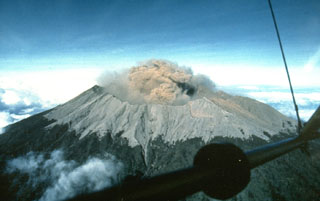Report on Raung (Indonesia) — 22 July-28 July 2015
Smithsonian Institution / US Geological Survey
Weekly Volcanic Activity Report, 22 July-28 July 2015
Managing Editor: Sally Sennert.
Please cite this report as:
Global Volcanism Program, 2015. Report on Raung (Indonesia) (Sennert, S, ed.). Weekly Volcanic Activity Report, 22 July-28 July 2015. Smithsonian Institution and US Geological Survey.
Raung
Indonesia
8.119°S, 114.056°E; summit elev. 3260 m
All times are local (unless otherwise noted)
PVMBG reported that the eruption at Raung was ongoing during 16-23 July. Ash plumes rose 2 km and incandescence at the crater was visible. Seismicity fluctuated but remained elevated. The Alert Level remained at 3 (on a scale of 1-4), and the public was reminded not to approach the crater within a 3-km radius. Based on PVMBG information, and satellite-image and pilot observations, the Darwin VAAC reported that during 22-28 July ash multiple ash plumes from Raung rose to varying altitudes of 4.3-5.2 km (14,000-17,000 ft) a.s.l. and drifted as far as 400 km NW, W, SSW, S, and SSE. A news article from 29 July noted that 18 flights at most had been canceled during the previous few days due to the ash plumes, and that the Notohadinegoro Airport (2,100 km SW) had been temporarily closed.
Geological Summary. Raung, one of Java's most active volcanoes, is a massive stratovolcano in easternmost Java that was constructed SW of the rim of Ijen caldera. The unvegetated summit is truncated by a dramatic steep-walled, 2-km-wide caldera that has been the site of frequent historical eruptions. A prehistoric collapse of Gunung Gadung on the W flank produced a large debris avalanche that traveled 79 km, reaching nearly to the Indian Ocean. Raung contains several centers constructed along a NE-SW line, with Gunung Suket and Gunung Gadung stratovolcanoes being located to the NE and W, respectively.
Sources: Darwin Volcanic Ash Advisory Centre (VAAC), Pusat Vulkanologi dan Mitigasi Bencana Geologi (PVMBG, also known as CVGHM), The Jakarta Post

